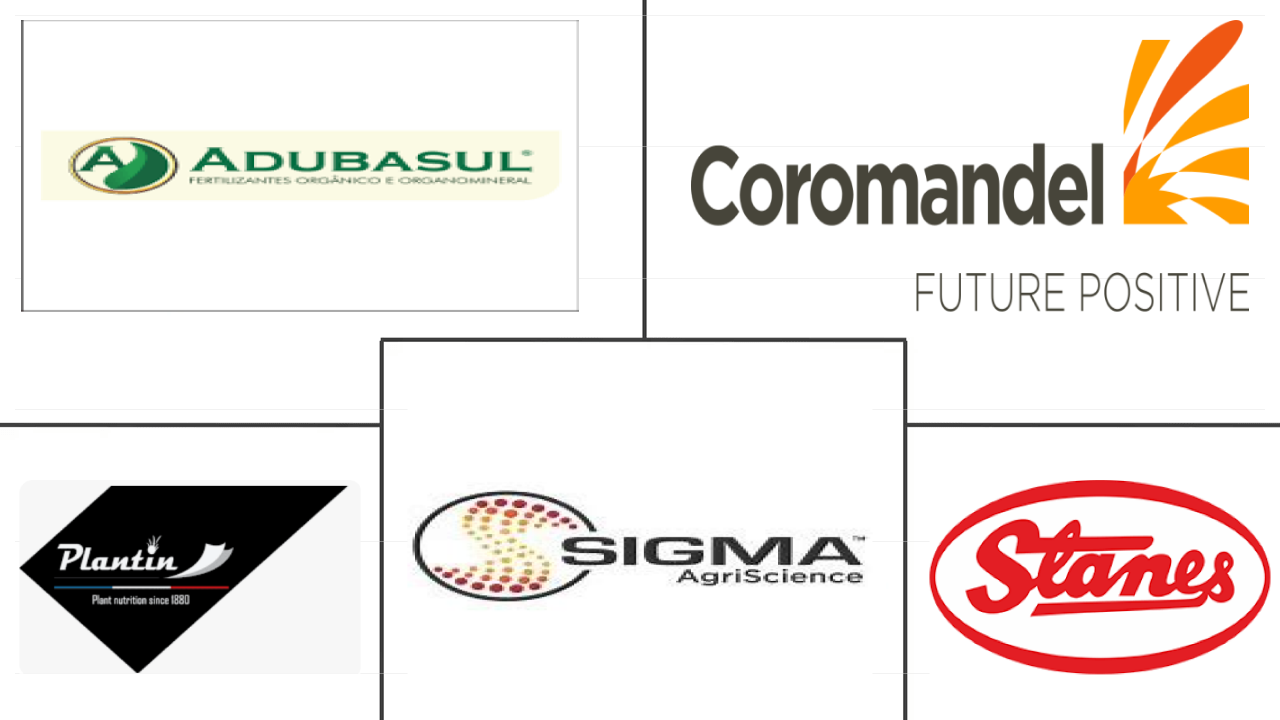Market Size of brazil organic fertilizer Industry
|
|
Study Period | 2017 - 2029 |
|
|
Market Size (2024) | USD 13.26 Million |
|
|
Market Size (2029) | USD 20.92 Million |
|
|
Largest Share by Form | Manure |
|
|
CAGR (2024 - 2029) | 9.55 % |
|
|
Fastest Growing by Form | Manure |
Major Players |
||

|
||
|
*Disclaimer: Major Players sorted in no particular order |
Brazil Organic Fertilizer Market Analysis
The Brazil Organic Fertilizer Market size is estimated at 13.26 million USD in 2024, and is expected to reach 20.92 million USD by 2029, growing at a CAGR of 9.55% during the forecast period (2024-2029).
13.26 Million
Market Size in 2024 (USD)
20.92 Million
Market Size in 2029 (USD)
4.84 %
CAGR (2017-2023)
9.55 %
CAGR (2024-2029)
Largest by Form
67.10 %
value share, Manure, 2023
Compost manure, Farmyard Manure, and green manure are the common types used in Agriculture. Cash crops dominated the manures segment with a volume share of 88.9 % in 2022.
Fastest by Form
9.84 %
Projected CAGR, Manure, 2024-2029
Green manure is more efficient and is widely used manure in Brazil. Cash crops dominated the manures segment with a volume share of 88.9 percent in the year 2022.
Largest by Crop Type
88.42 %
value share, Cash Crops, 2023
The major cash crops grown in brazil include sugarcane, coffee and cotton. Manures are the most consumed organic fertilizers by cash crops with market share of 94.3% in 2022.
Fastest by Crop Type
10.27 %
Projected CAGR, Row Crops, 2024-2029
Soyabean, wheat and corn are the major row crops grown in Brazil. Among the organic fertilizers, manures dominated the row crops segment with a market share of 87.8% in 2022
Leading Market Player
19.38 %
market share, Coromandel International Ltd, 2022

The company offers organic fertilizers to improve soil health, which are derived from natural sources such as city waste, sugarcane molasses, oil cakes, and gypsum.
- In Brazil, more than 50% of organic producers are situated in Minas Gerais, Pernambuco, Paraná, São Paulo, and Rio Grande do Sul states. Brazil is one of the world's leading organic farming countries. Around 85,000 hectares of the organic cultivation area is dedicated to soybean, wheat, corn, sugarcane, and cotton.
- Manure dominated the Brazilian organic fertilizers market with a share of 66.4% in 2022. Among different manures, green manure is more efficient and widely used in agriculture. Green manuring can be defined as plowing or turning undecomposed green plant tissues into the soil to improve the physical structure and soil fertility. Green manure, which is high in nutrients and protects the soil, must be incorporated into the soil before the flowering stage.
- Meal-based fertilizers accounted for 20.2% of the Brazilian organic fertilizers market in 2022. These fertilizers are dry, often single-ingredient additives that can be added to soil mixes or incorporated with other dry and top-dressed fertilizers. Common meals used as fertilizers include blood meal (high nitrogen), bone meal (high phosphorus and calcium), and kelp meal (low NPK, rich in minerals). All of them offer unique benefits to growers cultivating crops with specific needs.
- Many non-edible oil cakes, such as castor, neem, Madhuca, Karanja, linseed, rapeseed, and cotton seed, can be used as organic manure because they contain high levels of plant nutrients.
- Increasing concerns over the excessive use of chemical fertilizers, growing adoption of organic and sustainable agricultural practices, and rising demand for organic products are expected to drive the Brazilian organic fertilizers market during the forecast period.
Brazil Organic Fertilizer Industry Segmentation
Manure, Meal Based Fertilizers, Oilcakes are covered as segments by Form. Cash Crops, Horticultural Crops, Row Crops are covered as segments by Crop Type.
- In Brazil, more than 50% of organic producers are situated in Minas Gerais, Pernambuco, Paraná, São Paulo, and Rio Grande do Sul states. Brazil is one of the world's leading organic farming countries. Around 85,000 hectares of the organic cultivation area is dedicated to soybean, wheat, corn, sugarcane, and cotton.
- Manure dominated the Brazilian organic fertilizers market with a share of 66.4% in 2022. Among different manures, green manure is more efficient and widely used in agriculture. Green manuring can be defined as plowing or turning undecomposed green plant tissues into the soil to improve the physical structure and soil fertility. Green manure, which is high in nutrients and protects the soil, must be incorporated into the soil before the flowering stage.
- Meal-based fertilizers accounted for 20.2% of the Brazilian organic fertilizers market in 2022. These fertilizers are dry, often single-ingredient additives that can be added to soil mixes or incorporated with other dry and top-dressed fertilizers. Common meals used as fertilizers include blood meal (high nitrogen), bone meal (high phosphorus and calcium), and kelp meal (low NPK, rich in minerals). All of them offer unique benefits to growers cultivating crops with specific needs.
- Many non-edible oil cakes, such as castor, neem, Madhuca, Karanja, linseed, rapeseed, and cotton seed, can be used as organic manure because they contain high levels of plant nutrients.
- Increasing concerns over the excessive use of chemical fertilizers, growing adoption of organic and sustainable agricultural practices, and rising demand for organic products are expected to drive the Brazilian organic fertilizers market during the forecast period.
| Form | |
| Manure | |
| Meal Based Fertilizers | |
| Oilcakes | |
| Other Organic Fertilizers |
| Crop Type | |
| Cash Crops | |
| Horticultural Crops | |
| Row Crops |
Brazil Organic Fertilizer Market Size Summary
The Brazil Organic Fertilizer Market is experiencing significant growth, driven by the country's position as a leading organic farming nation. With a substantial portion of organic producers located in states like Minas Gerais, Pernambuco, Paran√°, S√£o Paulo, and Rio Grande do Sul, Brazil is at the forefront of organic agriculture. The market is characterized by a strong reliance on manure, particularly green manure, which is valued for its nutrient-rich properties and ability to enhance soil fertility. Meal-based fertilizers also play a crucial role, offering specific benefits through ingredients like blood, bone, and kelp meals. The increasing shift towards organic and sustainable agricultural practices, coupled with rising consumer demand for organic products, is propelling the market forward.
The organic fertilizer market in Brazil is further supported by the country's expansive organic cultivation area, which includes cash crops such as sugarcane, cocoa, coffee, and cotton. The replacement of chemical fertilizers with organic alternatives is not only environmentally beneficial but also economically advantageous, saving significant costs for farmers. Despite the higher prices of organic food, growing disposable incomes and health consciousness are expected to boost organic food consumption among Brazilian consumers. The market is fragmented, with key players like Adubasul Fertilizantes, Coromandel International Ltd, Plantin, Sigma AgriScience LLC, and T.Stanes and Company Limited leading the charge. Recent mergers and product launches, such as Coromandel International Ltd's bio-enriched organic manure, are anticipated to further enhance the market's growth trajectory.
Brazil Organic Fertilizer Market Size - Table of Contents
-
1. MARKET SEGMENTATION (includes market size in Value in USD and Volume, Forecasts up to 2029 and analysis of growth prospects)
-
1.1 Form
-
1.1.1 Manure
-
1.1.2 Meal Based Fertilizers
-
1.1.3 Oilcakes
-
1.1.4 Other Organic Fertilizers
-
-
1.2 Crop Type
-
1.2.1 Cash Crops
-
1.2.2 Horticultural Crops
-
1.2.3 Row Crops
-
-
Brazil Organic Fertilizer Market Size FAQs
How big is the Brazil Organic Fertilizer Market?
The Brazil Organic Fertilizer Market size is expected to reach USD 13.26 million in 2024 and grow at a CAGR of 9.55% to reach USD 20.92 million by 2029.
What is the current Brazil Organic Fertilizer Market size?
In 2024, the Brazil Organic Fertilizer Market size is expected to reach USD 13.26 million.

